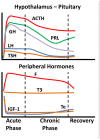Endocrine Aspects of ICU-Hospitalized COVID-19 Patients
- PMID: 36294842
- PMCID: PMC9604718
- DOI: 10.3390/jpm12101703
Endocrine Aspects of ICU-Hospitalized COVID-19 Patients
Abstract
The unprecedented scale of the current SARS-CoV-2/COVID-19 pandemic has led to an extensive-yet fragmented-assessment of its endocrine repercussions; in many reports, the endocrine aspects of COVID-19 are lumped together in intensive care unit (ICU) patients and non-ICU patients. In this brief review, we aimed to present endocrine alterations in ICU-hospitalized patients with COVID-19. There are tangible endocrine disturbances that may provide fertile ground for COVID-19, such as preexisting diabetes. Other endocrine disturbances accompany the disease and more particularly its severe forms. Up to the time of writing, no isolated robust endocrine/hormonal biomarkers for the prognosis of COVID-19 have been presented. Among those which may be easily available are admission glycemia, thyroid hormones, and maybe (OH)25-vitamin D3. Their overlap among patients with severe and less severe forms of COVID-19 may be considerable, so their levels may be indicative only. We have shown that insulin-like growth factor 1 may have prognostic value, but this is not a routine measurement. Possibly, as our current knowledge is expanding, the inclusion of selected routine endocrine/hormonal measurements into artificial intelligence/machine learning models may provide further information.
Keywords: COVID-19; SARS-CoV-2; blood; critical illness; human; plasma.
Conflict of interest statement
The authors declare no conflict of interest.
Figures
References
Publication types
LinkOut - more resources
Full Text Sources
Miscellaneous


